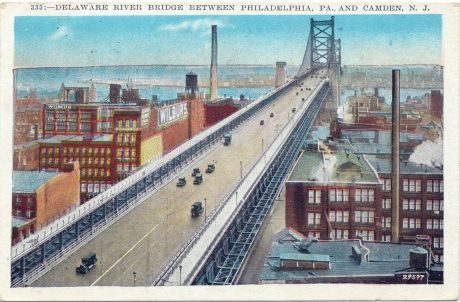Philadelphia, like many cities in the Global North, has augmented traditional, established, face-to-face workforce education services in public schools, community centers, and library programs with a constellation of digital services accessible through computers and, increasingly, internet-enabled smartphones. Such efforts underpinned conceptualizations of the smart city that IBM fostered and Philadelphia adopted beginning around 2010. These digital services format into a platform with the potential to increase civic engagement and job opportunities in novel ways by breaking down geographic barriers between inner-city residents of postindustrial neighborhoods and the locations of jobs in the new economy, which are typically either downtown or on the city’s suburban fringe. While this digitally driven project was rhetorically focused on a public good—jobs for marginalized residents—it is crucial to also examine how Philadelphia’s mayor enrolled this project into an economic development agenda that focused more on promoting innovative economic policy than actively achieving the job-creation goals of the project itself.

Smart city projects integrate information and communication technology (ICT) infrastructures into the provision of civic services. Their core implication is that mobile, digital technologies hold the potential to provide novel solutions to longstanding social and economic issues. Such an approach assumes that new technologies can effect change quickly, more efficiently, and for a lower price than a low-tech, “dumb” policy strategy. These efforts harness the ubiquitous connectivity and data-gathering potential of digital infrastructures: the internet and wireless mobile communication, smartphones and other computing gadgets, and also software, algorithms, and machine-sorted data in widespread use today. These networks and devices are built and maintained by massive, trans-national ICT corporations, not least Apple, Alphabet (Google’s parent company), AT&T, Cisco, Microsoft, and Oracle (Dullforce 2015). The complexity of digital systems—hardware, software, and data—leads to a unique set of experts and private institutions attached to the provision and maintenance of the infrastructure underpinning smart city policies and projects. This is a markedly different situation from other, more state-centric forms of public services such as the provision of water or transportation.
The logic of smart city policies builds off of the easy utility of personal connectivity to the mobile internet. This infrastructural connection acts as a platform to provide digital facsimiles of services previously offered through brick and mortar locations for civic interaction: replacing an office with an app. To this end, implementing “smart” solutions to urban issues adapts the ongoing, neoliberal cost-cutting in city governments into new digital systems like smartphones that earlier were used for social exchange but not to engage with public services (Hackworth 2007; Hollands 2008).

At issue is the expectation of smart city experts both that the digital solution is best, and that users will adopt said solution in the fashion the experts planned for. Here I present Philadelphia’s experience partnering with IBM to harness digital infrastructure and residents’ smartphones to provide a workforce education app that would both train residents with skills relevant for jobs in emerging industries and also connect residents to potential employers. With this case study, I focus on the inability of experts to foresee the sort of pitfalls that emerge when new technologies are deployed into the public sphere too quickly and without the knowledge resources on hand to adapt a prototype into a more complex “real-world” situation.
IBM emerged as a main actor providing smart city consulting starting around 2010 with their Smarter Cities Challenge (IBM 2013); they maintain the focus to the present day (Wiig 2015a). Worldwide, IBM’s Smarter Cities Challenge initiatives took the potential of ICT infrastructure to connect city to citizen in original, often untested ways. These initiatives proposed harnessing ICT’s potential to address a “matter of concern” (Latour 2004) decided by a city’s mayor and IBM. The topics IBM addressed were civic engagement, economic development, education, environmental health, public safety, transportation, and urban planning. IBM wrote plans and left implementation to civic intermediaries: city officials, nongovernmental organizations, and the private sector (Wiig 2015b:263). IBM provided the consultation for free; the city was responsible for funding, staffing, and deploying the effort on their own, even though finding staff trained to build civic technologies could be difficult (Interview, Director of Civic Technology, 2012).
Philadelphia requested IBM design an online and mobile app to implement digital literacy–focused workforce education training (Rowinski 2010). In addition, the app would contain a social media–styled component to connect trainees to potential employers. Philadelphia’s mayor noted that, by his office’s calculus, 600,000 city residents were unqualified for jobs in the twenty-first century information and innovation-focused economy (Nutter 2012a, 2012b). As a result, residents first needed workforce training for positions relevant to this emerging economy to secure jobs.
The program was called Digital On-Ramps, a reference to providing an on-ramp to the information superhighway (Interview, Director of school initiatives, 2013). In this conceptualization, for Philadelphia to become a smart city, it needed to improve on education and job attainment among marginalized, inner-city residents. Investing directly in public schools was fraught with local, state, and national politics: the city’s public schools have been failing for decades (Jack and Sludden 2013; Leblanc 2013; Maranto 2005). In addition, improving public schools wholesale would not provide a stage for deploying a technological solution to an audience of tech-savvy, “innovative” businesses that might have been identified to hire participants.
In deploying an app-based solution, the city and IBM sought to sidestep the contentious politics surrounding the underfunded public education system and bring workforce training straight into the hands of local youth via the smartphone many—if not most—likely carried with them everywhere. In this conceptualization of a smart city, smartphones and their connective digital infrastructure are deployed to solve the problem of underfunded public schools unable to provide relevant educational opportunities and linkages to jobs in the new economy.
In the fall of 2011, IBM’s team spent about two weeks in Philadelphia, interviewing 66 people from “city government, private sector employers, universities and colleges, schools and community-based organizations” (IBM 2011:21). From these interviews, the consultants chose “to view the Digital On-Ramps stakeholders in three groupings: citizens, providers, and employers” (IBM 2011:21). Absent from the interviewed stakeholders, however, were members of the public: citizens who might need workforce education. Their view was represented by the civic, nongovernmental, and private sector organizations working with the public. The planning document was presented to the city in late 2011 (IBM 2011). Development of the app began immediately.
Digital On-Ramps’ workforce education app, conceptualized by a steering committee and implemented by midlevel staff, would be accessed through a personal computer or smartphone. It would provide short lessons in a variety of digital skills that could be completed, for instance, during a participant’s commute to school via public transportation. An app platform for workforce education offered multiple sorts of flexibility. New lessons could be added and old removed remotely, an individualized learning plan for each participant could be created, and the app could grow users without necessarily requiring more teachers or support staff, or finding additional classroom space. The app could, in design, fulfill the learning needs of as many Philadelphians as were interested. Conceptualizing the lessons and crafting the achievable skillsets would happen through a badge-based system introduced by the Mozilla Foundation (Surman 2011) in which completing a suite of lessons would produce a badge, and a collection of badges could qualify a participant for a certain sort of job. This badge-based digital learning through a smartphone represented a path-breaking step forward for Digital On-Ramps and public education in Philadelphia more generally, but by the time of the pilot, the lessons and the badge system were not yet fully conceptualized, nor were the sort of jobs for which the training would qualify participants.
A pilot took place in the spring of 2013 involving more than 500 local youth at four public high schools. Garnering the interest of this many youth was seen as a prominent success for the pilot (Interview, Director of School Initiatives, 2013), which targeted the advanced manufacturing industry. This was part of the push to bring precision, flexible manufacturing back to the United States, one of the Obama administration’s economic goals in 2010 (Science and Technology Policy Institute 2010). When asked to identify the specific sort of jobs for which Digital On-Ramps participants received training, staff was reluctant to provide an answer. The only concrete example given was a photocopier technician, responsible for printing and maintaining the paper output of an office (Interview, Development Manager, 2013).
The pilot quickly ran in to multiple problems: miscommunication between Digital On-Ramps’ staff and teachers at the involved high schools meant no one assisted the youth as they navigated through the lessons. The app’s programming, done by a third party not located in Philadelphia, had technical problems such as no way for a participant to automatically generate a new login password if they forgot their existing one. The piloted lessons were not even available as an app: they only worked through the web browser on a desktop, so the youth could not continue the lessons on their smartphone later in the day (Wiig 2015b:6–13). Digital On-Ramps’ staff was pushed to implement the app without adequate resources, most importantly a software provider up to the task of coding the app they needed, on a too-short timeline. While this was not inherently the fault of any one expert, it speaks to the complications in relying on, in this case, computer and app programmers working at a distance to provide a core element of the digital education system.
Digital On-Ramps emerged at the intersection of multiple public and nongovernmental education organizations in Philadelphia, groups that historically had worked without effective coordination of services and resources. One important success of this smart city effort, mentioned by multiple interviewees across all the involved organizations, was that partnering with IBM finally made them communicate with each other. However, the mayor’s and the steering committee’s demand for brand new, innovative programming meant that the proposed app did not sync with existing vocational programs in the city. An assumption underlying the effort was that to be “smart” necessitated creating something path breaking. This was also illustrated by the focus on advanced manufacturing, an industry cluster that, while represented in the city, was small and likely unable to provide jobs in the way an established, but perceived as less innovative, field could, such as health care.
The planning challenges Digital On-Ramps faced did not stop the mayor from proclaiming the program a success even before the pilot ran (Wiig 2015b). The potential for widespread public benefit was operationalized to promote Philadelphia and IBM’s innovative, entrepreneurial capacity, without taking into account how to actively achieve the goals of the plan. The parameters of success as planned by IBM and promoted by Digital On-Ramps’ steering committee and the mayor were not met: the bombastic hype of app-based workforce education as a vehicle for economic promotion was the most prominent outcome of the project. Today, Digital On-Ramps has scaled back their vision to focus on more attainable workforce education and job creation outcomes: connecting residents to jobs, providing career advice, and hosting an online e-portfolio site where participants can upload resumes, certifications, and recommendations (Digital On-Ramps 2014).
Digital On-Ramps targeted a particular population; the process of targeting, in turn, produced particular “problems” for which an app could then provide the solution. Enabled through digital infrastructure’s constant, mobile connectivity, Digital On-Ramps crafted a public in need of skills for a new industry that did not yet exist in the city, but through the process of gaining workforce education, the new industry would see that Philadelphia was a “smart” city in which to locate. This digital solution to a lack of job skills, general unemployment, and the need for economic growth was originally framed in terms of 1) convenient attainment of targeted, almost vocational training for jobs in a new economy, and 2) social media–style knowledge coordination providing employers with better access to potential employees. With Digital On-Ramps, private, non-state actors like IBM defined new understandings of the public for the state, a public that was conversant in and comfortable with digital technologies, perhaps lacking more specific, job-relevant, and professional digital skills, but amenable to learning said skills as well as seeking jobs in this new economy. While IBM’s planning did not (or could not) foresee the social and technological problems participants ran into, Digital On-Ramps’ steering committee, with their focus on advanced manufacturing seeking to align the city’s economy into new, relevant industries, was unable to adequately provide the connections to employers promised to participants. The advanced manufacturing industry likely did not need many photocopier technicians. In a fashion, Digital On-Ramps ran into a chicken-or-egg, which-comes-first conundrum: they needed participants interested in jobs, but they also needed potential employers willing to hire participants through new means. Digital On-Ramps’ shift since the pilot into a more realistic and less ambitious plan to align education with job opportunities, without the online, mobile education component, will hopefully realize some success, even if it does not attain the smart city ambitions originally proclaimed. As future smart city projects of this sort are planned, it is important to consider, in a smart city, who is the public and how will they benefit from the project.
